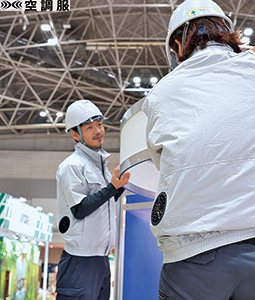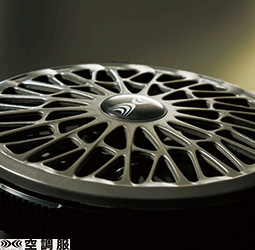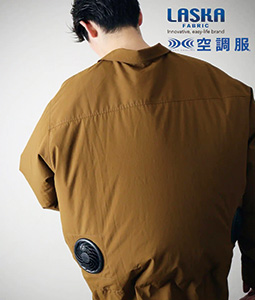
Workers’ Kuchofuku (空調服™) jackets billow with fan-blown air 
Image showing the direction of airflow inside a Kuchofuku (空調服™) fan-equipped jacket 
A miniature fan used in Kuchofuku (空調服™) clothing 
Loose-fitting silhouette Kuchofuku (空調服™) shirt. Collaboration with the LASKA label (JOURNAL STANDARD), BAYCREW'S Co., Ltd.
August 2021
Cooling the Body with Fan-Equipped Clothes

Japan is seeing the rapid spread of work clothes that aim to protect against heat as well as reduce CO2 emissions.

The Japanese summer is very hot and very humid. Especially in recent times, successive years have seen severe heatwaves with a danger of heatstroke for people working in factories and outdoors. A certain type of work clothes is currently spreading rapidly in such workplaces. It is Kuchofuku (空調服™), a brand of fan-equipped clothes with fans installed in the back. The fans attached to the clothes suck outside air into the clothes, evaporating sweat, thereby releasing heat through vaporization and cooling the body. The clothing was developed by Ichigaya Hiroshi, a former Sony engineer and the founder and chairman of Kuchofuku Co., Ltd.
The trigger to Ichigaya’s development of Kuchofuku clothing was a business trip he made to Southeast Asia to sell his former company’s products in the 1990s.

He explains, “At the time, the economies of countries like Thailand and Malaysia were growing rapidly, so big buildings were being constructed all over the place. Seeing those urban areas, I thought, ‘If in the near future developing countries start habitually using air conditioners like the Japanese do, then there’ll be an energy crisis. We need cooling devices that save energy.’”
“It takes a large amount of energy to fully cool a space such as a room. So, is it somehow possible to just cool the air around each person?”
With these thoughts in mind, Ichigaya started developing products that make people feel cool by just wearing a piece of clothing. The first prototype developed in 1999 pumped water from a water tank attached to the waist, wet a cooling cloth in the back of the clothes, and removed heat by having a fan vaporize the water. However, Ichigaya gave up on this idea since water leaked from the joint between tank and pipe.

Was there no way to release heat through vaporization without making the clothes wet? He was exploring this question when the idea came to him of using sweat.
Ichigaya comments, “Humans perspire to prevent skin temperature from increasing too much and we have the ability to maintain optimal temperature by reducing skin temperature through vaporization as sweat evaporates. I decided to use this mechanism.”
By attaching fans around the waist and having the air circulate around the whole upper body before exiting at the collar and cuffs, it is possible to efficiently evaporate sweat. Ichigaya named this mechanism the “Theory of Physiological Air Conditioning (生理クーラー®)” and commenced development. He first had to pick the fabric knowing that to efficiently circulate the air he needed a material that did not leak air. After testing more than 1,000 fabrics, he selected the most optimal. He also used ingenuity in the fan development, such as adjusting the shape and placement of the blades with millimeter precision, to ensure strong force, low power consumption, and quiet sound.

In 2004, he finally completed a product he was happy with and released it on the market. Sales did not grow as much as he had expected in the decade that followed, but the word gradually started getting around among workers at farms and construction sites across Japan, and it became a hit product with sales of 360,000 items in 2016.
“I got many happy comments from users, such as, ‘I used to not be able to eat due to the heat every summer and had to work while on an intravenous drip, but I don’t need to anymore thanks to Kuchofuku. Now, I can’t work without them.’ Whenever I hear the sincere feelings of regular users, I feel working so hard to develop the clothing was worth it.”
In 2017, Kuchofuku was recognized for its power-saving and CO2 emission-reducing effects as heat protection, and was awarded the Minister of the Environment’s Commendation for Global Warming Prevention Activity. At present, it is not only sold as work clothes but is also marketed in cooperation with apparel brands and outdoor clothing makers, and as products for women and children.
There are many countries around the world that are hotter than Japan. Ichigaya’s immediate goals—over the next five to ten years—are for Kuchofuku to be popularized not just as work clothes but also as something anyone can wear without it feeling strange while moreover contributing to preventing global warming. Filled with such hopes, Ichigaya keeps on working to improve his Kuchofuku.
The provided items use patents and technologies by SFT LABORATORY, Co., Ltd. and KUCHOFUKU Co., Ltd.
“空調服” is a trademark or a registered trademark by SFT LABORATORY, Co., Ltd. and KUCHOFUKU Co., Ltd. in Japan. (Registered Classes: 9, 10, 11, 12, 17, 20, 24)
“空調服” and “生理クーラー” are registered trademarks by SFT LABORATORY, Co., Ltd. and KUCHOFUKU Co., Ltd. in Japan.

